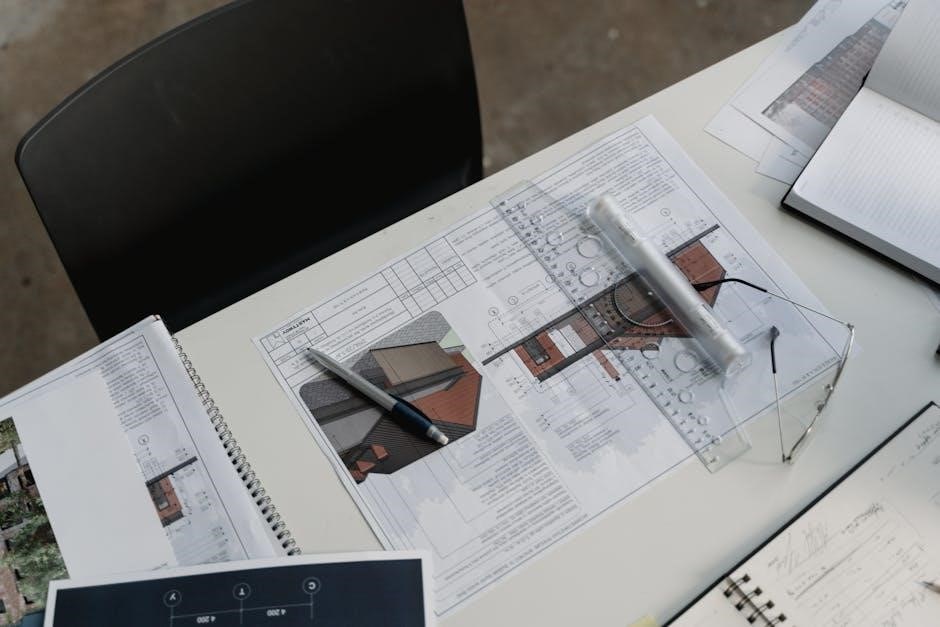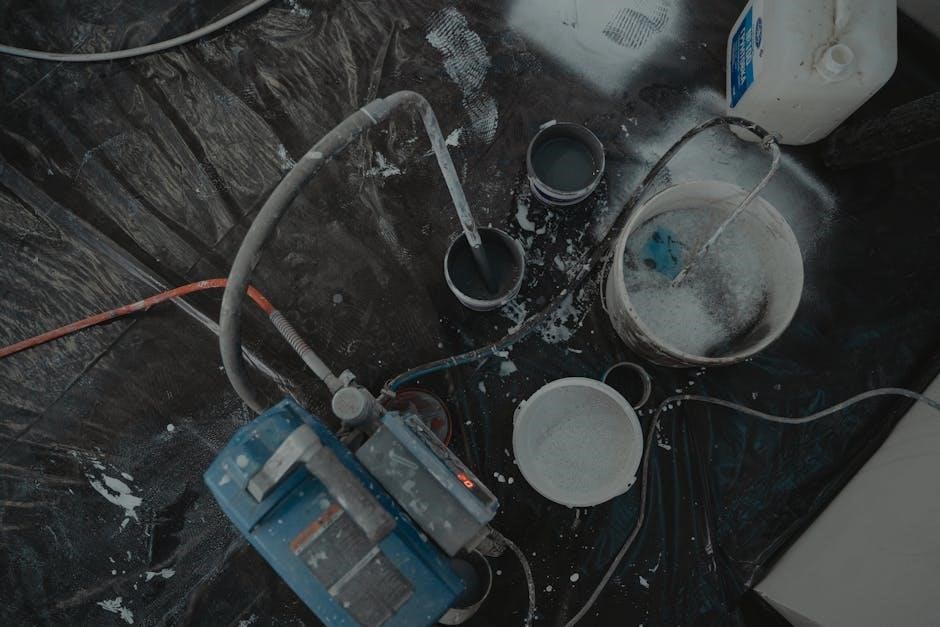Discover easy-to-follow PDF blueprints for building picnic tables, featuring various designs like traditional, hexagon, and folding options. Perfect for DIY enthusiasts, these plans include material lists, step-by-step instructions, and video tutorials to ensure a successful project. Ideal for both beginners and experienced woodworkers, these blueprints offer customizable solutions for creating durable and stylish outdoor furniture.
Overview of Picnic Table Designs
Picnic table designs vary widely, offering options for every style and space. Traditional models feature rectangular tabletops with attached benches, while hexagon and octagon designs provide unique, visually appealing shapes. Round picnic tables are ideal for smaller areas, promoting conversation and intimacy. Folding picnic tables are portable and versatile, perfect for temporary setups. Small picnic tables are great for limited spaces, while large ones accommodate bigger gatherings. Detached bench designs allow for more flexibility, and some plans include storage solutions for added functionality. These designs cater to different preferences, ensuring there’s a picnic table to suit any backyard, deck, or patio. Whether you prefer classic simplicity or innovative layouts, the variety of picnic table designs offers something for everyone, making it easy to find a plan that matches your needs and skill level.
Benefits of Using PDF Blueprints
Using PDF blueprints for picnic table plans offers numerous advantages. These documents provide clear, detailed instructions with measurements, material lists, and step-by-step guides, ensuring accuracy and ease of understanding. PDFs are easily accessible on multiple devices, allowing you to reference plans wherever you are. They often include diagrams and visuals, which help visualize the project. Many PDF blueprints are customizable, enabling you to adjust designs to suit your preferences. Additionally, they save time by providing optimized material lists, reducing waste and costs. Video tutorials and troubleshooting tips are often included, making the building process smoother. Overall, PDF blueprints are a convenient and comprehensive resource for DIY enthusiasts, ensuring a successful and stress-free picnic table building experience.

Materials and Tools Required

Building a picnic table requires 2×6 and 2×4 lumber, screws, nails, and wood glue. Essential tools include a saw, drill, screwdriver, and sandpaper. Preparing all materials ensures a smooth building process.
Lumber and Wood Specifications
For a durable picnic table, use pressure-treated lumber or naturally rot-resistant wood like cedar. Opt for 2×6 boards for the tabletop and seats, and 2x4s for the frame. Ensure all lumber is straight and free of knots. Cut boards to the specified lengths, sanding edges for safety. Avoid warping by selecting wood with consistent moisture content. For a polished look, consider sealing the wood with a waterproof finish. Proper material selection ensures stability and longevity, making your picnic table suitable for outdoor conditions. Always follow the cutting list provided in your PDF blueprint to minimize waste and ensure accuracy. Choosing high-quality lumber is key to a professional-grade finish and lasting durability.
Hardware and Fasteners Needed
Galvanized lag screws and carriage bolts are essential for assembling the picnic table frame, ensuring durability and weather resistance. Use 3-4 inch lag screws for securing legs and frame joints, while 1-2 inch wood screws are ideal for attaching tabletop planks and benches. Metal washers and nuts provide additional stability. For added strength, consider using corner brackets or metal braces. Pre-drill holes to avoid splitting the wood. All hardware should be rust-resistant to withstand outdoor conditions. Follow the PDF blueprint’s hardware list for precise quantities and sizes. Properly tightened fasteners ensure the table remains stable and secure. Weather-resistant materials guarantee long-lasting performance, even in harsh climates. Always double-check hardware specifications to match your lumber dimensions for a sturdy build.

Essential Tools for the Project
Building a picnic table requires basic woodworking tools for precise cuts and assembly. A circular saw is ideal for cutting lumber to size, while a drill ensures accurate holes for screws and bolts. A tape measure and square are crucial for measuring and aligning components. Sandpaper smooths wood surfaces, preventing splinters. A wrench or socket set tightens bolts and nuts securely. Clamps help hold pieces in place during assembly. A level ensures the table is even and stable. Optional tools like a miter saw or impact driver can speed up the process. Proper tool maintenance and safety gear, such as gloves and safety glasses, are essential for a safe and successful build. Having all tools ready beforehand streamlines the assembly process, making the project more enjoyable and efficient.

Popular Picnic Table Designs
Explore various picnic table designs, including traditional, hexagon, octagon, round, and folding options, each offering unique styles and functionalities for different outdoor settings and preferences.
Traditional Picnic Table
The traditional picnic table is a timeless design, perfect for outdoor dining and gatherings. Its simple yet durable construction makes it a favorite for backyard, park, or deck settings. Typically featuring a rectangular tabletop with attached benches on both sides, this classic style offers ample seating and a sturdy surface for meals. Made from weather-resistant wood like cedar or pressure-treated lumber, it withstands outdoor elements. The straightforward design allows for easy assembly, making it a popular choice for DIY projects. With free PDF blueprints widely available, builders can access detailed plans, material lists, and step-by-step instructions to create a traditional picnic table that lasts for years. Its versatility and enduring appeal ensure it remains a top pick for outdoor enthusiasts seeking a reliable and charming dining solution.
Hexagon and Octagon Picnic Tables
Hexagon and octagon picnic tables offer a unique, visually appealing alternative to traditional designs. These multi-sided tables provide excellent space utilization and a modern aesthetic, making them ideal for social gatherings. Perfect for fitting into irregularly shaped areas or creating a focal point in your yard, these designs often feature a central table with surrounding benches. Durable materials like cedar or recycled plastic ensure longevity, while the geometric shape adds charm. Many free PDF blueprints include detailed instructions for constructing these models, catering to both beginner and experienced woodworkers. The hexagon and octagon styles are particularly popular for their ability to accommodate larger groups comfortably. With customizable options, these designs allow you to enhance your outdoor space with a functional and stylish seating solution that stands out from the crowd.
Round and Folding Picnic Tables
Round and folding picnic tables are excellent choices for versatility and convenience. Round tables offer a compact, space-saving design, ideal for smaller yards or intimate gatherings, while folding tables provide portability and easy storage. Many PDF blueprints feature lightweight materials and detachable legs for effortless transport. These designs are perfect for outdoor events, camping, or small patios. Folding picnic tables often include hinges and latches for quick assembly and disassembly, making them a practical option for temporary setups. Round tables, with their smooth edges, are particularly child-friendly and encourage conversational seating. Both styles are widely available in free PDF plans, catering to various skill levels and preferences. Whether you need a permanent or temporary solution, these designs offer durability, functionality, and a touch of modern style to enhance your outdoor spaces.
Small and Large Picnic Table Options
Picnic table plans cater to diverse needs with options ranging from small, toddler-sized designs to large, 8-foot tables for bigger gatherings. Small tables are perfect for limited spaces, offering portability and ease of assembly, while large tables provide ample seating and durability for heavy use. Many blueprints include adjustable designs, allowing you to customize the size to fit your specific requirements. Materials like cedar or pressure-treated wood ensure longevity, and some plans incorporate detachable benches for added flexibility. Whether you’re building for a cozy family setup or a community space, these plans offer scalable solutions to meet your needs. With clear instructions and adaptable designs, you can create a picnic table that perfectly suits your outdoor environment and lifestyle.

Detailed Step-by-Step Instructions
Follow clear, organized guides to build your picnic table, from preparing materials to final assembly. Instructions include cutting, assembling frames, attaching tabletops, and ensuring stability for a durable finish.
Preparing the Site and Materials
Start by clearing a flat, level area for assembly. Gather all materials, including lumber, hardware, and tools. Ensure the site is free from debris and obstructions. Organize tools like circular saws, drills, and wrenches for easy access. Measure and cut lumber according to the blueprint specifications. Sort and label pre-cut pieces to streamline assembly. Sand all wood surfaces to smooth rough edges and ensure safety. Double-check the material list to confirm all components are available. If using treated wood, allow it to dry completely before assembly. Plan the workflow to minimize wasted time and materials. Finally, ensure the site is well-lit and safe for working. Proper preparation ensures a smooth and efficient building process, reducing errors and enhancing overall results.
Assembling the Table Frame
Begin by constructing the table frame using pre-cut 2×6 lumber for legs and supports. Attach the side rails to the legs with 3-inch screws, ensuring a sturdy base. Use clamps to hold the pieces in place while drilling pilot holes to prevent splitting. Next, assemble the frame by securing the top and bottom crossbeams. Tighten all bolts firmly but avoid overtightening, which could warp the wood. Double-check the frame’s squareness by measuring diagonals. If necessary, adjust the joints for proper alignment. Once the frame is secure, flip it over and ensure it rests evenly. Sand any rough edges or splinters for a smooth finish. This step is crucial for building a stable and durable picnic table that will withstand outdoor conditions and frequent use.
Attaching the Tabletop and Benches
After assembling the frame, place the tabletop planks (typically 2×6 lumber) evenly spaced on top of the frame. Secure each plank with 3-inch screws, ensuring they are tightly fastened but not overtightened. Repeat the process for the benches, attaching them to the side frames with screws. Make sure the benches are level and align properly with the tabletop. Use clamps to hold the planks in place while drilling to avoid movement. Sand all edges to smooth out any rough spots. Finally, double-check the alignment and tighten all screws for a sturdy finish. This step ensures the tabletop and benches are securely attached, providing a stable and comfortable seating area for outdoor gatherings.
Ensuring Stability and Leveling
Stability is crucial for a safe and functional picnic table. Begin by placing the assembled table on a flat surface and using a spirit level to verify that the frame is even. If the ground is uneven, use plastic or wooden shims under the legs to achieve balance. Flip the table over and check for any rocking or wobbling. Ensure the tabletop overhangs are equal on all sides by adjusting the screws or supports. For added stability, consider adding diagonal braces between the legs and frame. Sand any rough edges and tighten all fasteners to ensure a sturdy structure. Proper leveling ensures the table remains stable during use, preventing any accidental tipping or movement. This step is essential for creating a durable and long-lasting picnic table that withstands regular use and outdoor conditions.

Customization and Additional Features
Elevate your picnic table with customizable options like detached benches, storage compartments, or personalized designs. Add a unique touch with engravings or color finishes for a bespoke look. Blueprints often include these enhancements to make your project truly special and functional.
Adding a Detached Bench

A detached bench offers a practical and stylish way to enhance your picnic table setup. This feature provides additional seating while maintaining a clean, open layout. Many PDF blueprints include plans for detached benches, allowing you to customize your project further. With step-by-step instructions, you can easily construct a bench that matches your table’s design. The process typically involves cutting lumber to specified dimensions, assembling the frame, and securing the seat and backrest. Detached benches are ideal for creating a versatile outdoor dining area, as they can be rearranged or used separately. Some plans even include optional armrests or storage compartments for added convenience. By incorporating a detached bench, you can create a functional and inviting space for family gatherings or casual meals. This customization option is a great way to maximize comfort and flexibility in your outdoor setup.
Incorporating Storage Solutions
Incorporating storage solutions into your picnic table design can enhance functionality and organization. Many PDF blueprints offer plans for built-in storage compartments, such as shelves or cabinets, to keep outdoor items like cushions, utensils, or games within easy reach. Some designs include storage under the tabletop or within the benches, providing a practical way to maintain a clutter-free space. These features can be customized to fit your needs, whether it’s a small compartment for accessories or larger spaces for bulkier items. Adding storage not only improves the table’s usability but also adds value to your outdoor setup. With clear instructions and diagrams, PDF plans make it easy to integrate these convenient solutions seamlessly into your picnic table project.
Personalizing the Design
Personalizing your picnic table design allows you to tailor it to your specific needs and preferences. Many PDF blueprints offer customization options, such as choosing between hexagon, round, or folding designs. You can also adjust the size to fit small or large gatherings. Adding personal touches, like engravings or paint, can make the table unique. Some plans include options for detached benches or built-in storage, enhancing functionality. Whether you prefer a traditional look or a modern style, PDF plans provide flexibility to adapt the design to your outdoor space. This ensures your picnic table not only serves its purpose but also complements your yard’s aesthetic. With customizable features, you can create a one-of-a-kind piece that reflects your personality and meets your practical needs.

Free PDF Download and Resources
Access free PDF blueprints for picnic tables, including material lists and step-by-step guides. Explore various designs, from traditional to hexagon and detached bench options, to suit your outdoor space.
Where to Find Free Picnic Table Plans
Find free picnic table plans on websites like Ana White, MyOutdoorPlans, and Instructables. These platforms offer downloadable PDF blueprints for various designs, including traditional, hexagon, and octagon tables. Many plans include detailed material lists, step-by-step instructions, and diagrams to guide you through the building process. Some sites also provide video tutorials for added clarity. Whether you’re a beginner or an experienced woodworker, these resources cater to all skill levels. Additionally, forums and DIY communities often share user-created plans, allowing you to explore unique and customizable designs. With so many options available, you can easily find a plan that fits your space, style, and budget. Start your project today with these accessible and comprehensive resources!
Downloading Material Lists and Blueprints
Downloading material lists and blueprints for picnic tables is straightforward and convenient. Most websites offer free PDF downloads that include detailed cut lists, shopping lists, and step-by-step instructions. These documents are designed to be user-friendly, ensuring you have everything you need to start your project. Many plans also include diagrams and measurements to help visualize the assembly process. Simply visit reputable DIY websites, select your preferred picnic table design, and download the PDF; Some plans even offer imperial and metric measurements to accommodate different regions. Once downloaded, print or save the blueprint for easy reference during construction. This streamlined process ensures you can focus on building your picnic table without unnecessary delays. Make sure to review the material list before heading to the hardware store to avoid missing any essential items.
Video Tutorials and Additional Guides

Video tutorials and additional guides are invaluable resources for building a picnic table. Many websites offer step-by-step video instructions that complement the PDF blueprints, making it easier to understand complex assembly steps. These videos often cover topics like cutting lumber, attaching hardware, and ensuring stability. Additional guides may include tips on sanding, staining, and sealing the wood to enhance durability. Some tutorials also focus on specific designs, such as hexagon or folding tables, providing detailed insights for unique builds. These resources are particularly helpful for beginners, as they offer visual guidance and troubleshooting tips. By combining video tutorials with your PDF blueprint, you can tackle the project with confidence and achieve professional-looking results. Ensure to explore these resources for a smoother and more enjoyable DIY experience.
Building a picnic table with PDF blueprints is a rewarding DIY project. With clear plans and resources, you can create a durable, stylish outdoor space for endless enjoyment.
Final Tips for a Successful Build
For a successful picnic table build, ensure all cuts are precise and joints are secure. Use weather-resistant wood and hardware for durability. Sand all surfaces for a smooth finish and apply a protective sealant if desired. Double-check measurements and alignments before final assembly to avoid costly mistakes. Consider adding a finish like paint or stain for personalization. Test the table’s stability and leveling before use. Follow the PDF blueprint carefully, and don’t hesitate to consult video tutorials for tricky steps. Proper planning and attention to detail will result in a sturdy, long-lasting picnic table perfect for outdoor gatherings and family enjoyment.
